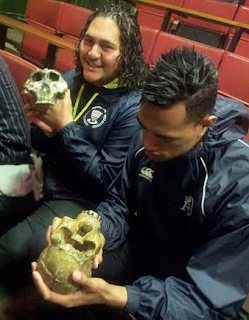Year 13 Bio has been learning about Human Evolution for the last 2 weeks; as you can see below, Mokani has been receiving encouragement and support in his learning from Bones aka the freshly renamed "Sally the Skelly"
On Thursday last week we attended the Auckland Zoo Trends in Human Evolution session. This began by students comparing the skulls of a human, chimpanzee and gorilla.
Key vocab about the skull differences included:
Foramen magnum
Zygomatic arches
Sagital crest
Nuchal crest
Masseter muscles (chewing muscles)
Brow ridges
Parallel (hominid) or parabolic (human) jaws and teeth
Protruding jaws
Canine teeth for aggression or not
Next, in pairs or threes students were given 2-3 skulls and asked to work out which was the most primitive, and which was the most recent, using what they had just learned from the compare-contrast activity.
Sela and Siale making friends with their skulls
Mokani and John looking at the zygomatic arches (cheek bones)
Rapture thinking about her skull..
Our student teacher Miss Graaf sharing her knowledge with the boys.
Then we compared the full skeletons of humans and gorillas, which from top-down included:
shoulder joints,
shoulder blades,
rib cages,
spinal shape,
arm length,
wrist joints,
palm length,
finger curve or not,
thumbs and grips (precision grip for humans),
pelvis shape,
gluteus maximus attachments and size
valgus angle,
leg length,
ankle joints,
grasping big toes or straight big toes,
arches in feet
The next activity was to bring all the skulls to the table and try to work out their order overall. This also included working out which skull was Ardi and which one was Lucy! Turns out that Lucy also had a male friend with her, showing sexual dimorphism as his skull was significantly larger than her own.
We found out that the main pattern that has developed over time is an increase in cranial capacity (cc), or brain size in comparison to body size. Species in the Homo genus have much larger brains for their size, and humans in particular have a large forehead with room for a frontal lobe. We know what frontal lobes are responsible for because of Phineas Gage's injury with a tamping iron... Having a larger brain allows for more complex behaviours, planning, problem solving, and communication.
Then we moved on to tools! Everyone was given a bag with a replica tool inside of it, and asked to put their hand inside and imagine how to hold it, whether there was a comfortable way, what it might be used for.. then we took them out, looked at them, and grouped them:
Oldowan tools are associated with Homo habilis (aka Handy Man) and are also called Pebble tools. They are basically the core of a rock shaped by a few blows to have a sharp edge. They were mostly used for smashing or crushing.
Archeulean tools have a typical teardrop shape. They are kind of like the swiss army knife of tools - they can be used for smashing, crushing, throwing, stabbing, slicing, as a hand axe etc. The core of the rock is still the main tool. These teardrop Acheulean tools remained fairly unchanged for 1 million years!
1.5 million years ago (mya) if you were holding this Acheulean tool, you were holding the most sophisticated technology on the planet.
Mousterian tools were less generalised and more specialised for different jobs like slicing, cutting, spear heads, hand axes, etc. They are usually made from flint. They were often made from the flakes that come off the core, and require a lot more planning to make.
We concluded our trip with a wet walk around the zoo in the rain for an hour. We got to see a baby giraffe, the new Auckland elephant, 2 sleepy lionesses, a curious meerkat who came and said hi, a red panda doing laps up and down a tree and John holding a convincing conversation with a flamingo.
In other news, Tamaki College may be getting some of our own ancient skulls from +Karen Ferguson and her awesome 3D printer! Different African fossils can be downloaded from this website, if anyone else has a 3D printer at their school :)









Thanks for sharing, nice post! Post really provice useful information!
ReplyDeleteAn Thái Sơn với website anthaison.vn chuyên sản phẩm máy đưa võng hay máy đưa võng tự động tốt cho bé là địa chỉ bán máy đưa võng giá rẻ tại TP.HCM và giúp bạn tìm máy đưa võng loại nào tốt hiện nay.